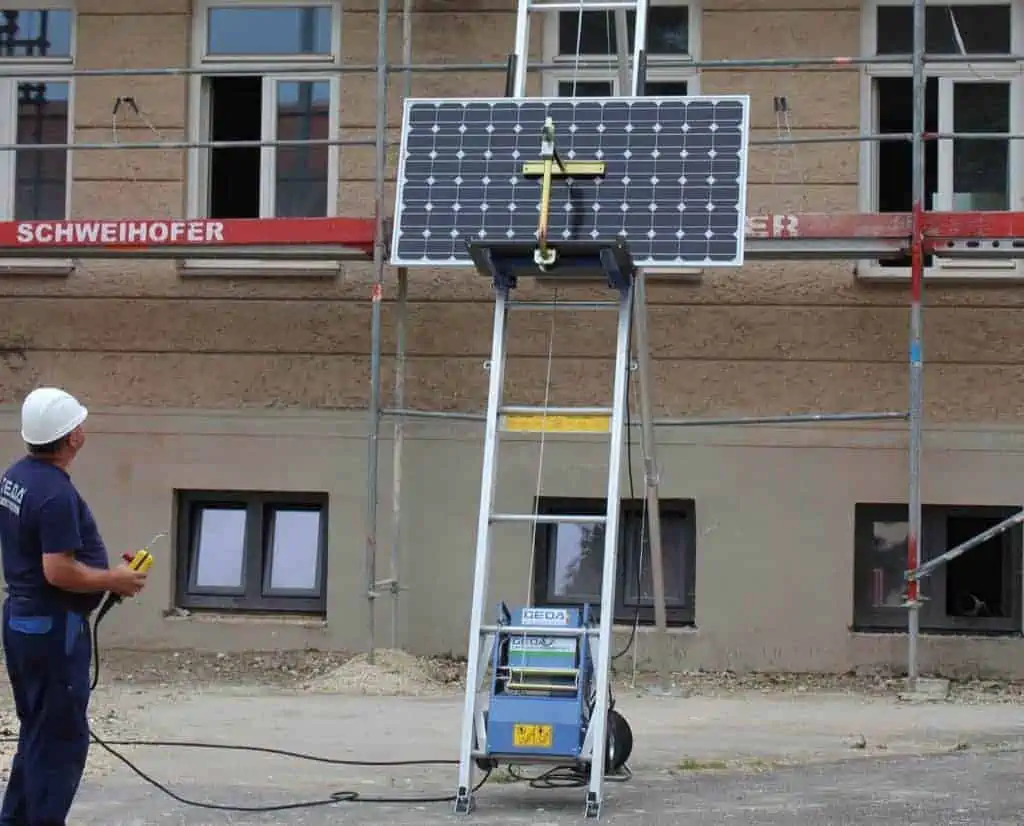Hoisting materials are some of the indispensable equipment in construction. You will notice at least one type of hoist at every construction site. Hoists lift materials and even workers vertically to transport them to job sites at heights. Most types of hoists use diesel as fuel.
Other than that, due to the massive development of technological equipment, several construction workers use electric hoists, which are way faster and safer.
In earlier times, when there was minimal use of technology and electric power, roofers and other construction workers used to rely on ladders to reach certain heights.
But construction workers needed something more to solve the issue of sending materials to the job sites above. However, today, a ladder lift or ladder hoist is very much used to lift construction materials to the roof or the heights.
In this blog post, we will discover everything you need to know about ladder hoists. So, stay tuned!

What is a Ladder Hoist?
Construction workers and roofers frequently use a ladder hoist or a ladder lift in several construction sites. You can even use it to work on the roofs of your house.
Most often than not, construction employees need machinery to safely lift materials from the ground and deposit them at heights.
So, maximum of the time, ladder hoists work as a helpful resource in specific tasks where workers don’t need to climb a ladder with heavy materials. Instead, they can lift the roofing or any other construction material using a ladder hoist.
Most of these construction materials are heavy.
So, they need to get lifted to the roof. But if a construction worker does the job instead of a hoist, it leaves plenty of room for injuries. In addition, lifting materials by hand contributes to less productivity and damaged quality of work while taking way more time.
What is a ladder lift made of?
Ladder hoists or lifts are typically crafted from aluminum. But the cable itself is a metal twine rope.
However, things can get unique material-wise in terms of the platform itself. For instance, if you decide to make the ladder hoist for yourself, you could also use a solid wooden platform.
The aluminum ladder frame is a vital component of the whole system. These ladders must be sufficient for the added load of a ladder lift system, and most lifters of this design come with ladders to ensure the correct motorized platform unit is in use.
The platform gets attached to the ladder, and then it can move along the vertical legs of the ladder. It moves using a ground-controlled cable system or a rack and pinion system. The motor is mounted on the ladder’s base to improve usability and add weight to the base for stability.
But you need to remember to be cautious about whatever material you use. You must use robust and sufficient wood to cope with heavy objects. Another helpful thing to consider is to connect the platform to the body of the ladder efficiently.
Different applications of ladder lifts
● Usage of Ladder hoists for Contracting materials:
The ladder hoists come with a spread of attachments to accommodate the equipment and accessories of a construction job site.
● Usage of ladder hoists for Roofing materials:
The ladder hoists or lifts can easily carry roofing substances from ground level to the pinnacle of a building. It cuts off the hard work of construction workers and removes the possibility of broken or damaged materials.
● Usage of Ladder hoists for Solar Panels:
Ladder lifts or ladder hoists simplify the process of shipping fragile solar panels and photovoltaic materials at a height quickly.
How do construction workers operate a ladder lift?
Operating ladder hoists are pretty straightforward and, in most cases, needs no experienced hands. The operator should stand at the bottom of the ladder to operate it perfectly. One can quickly activate the ladder hoist by pressing the hand lever down.
The platform lifts the materials to another worker at the top or on the roof to hold the construction materials. When the unit reaches the roof or the desired top, an operator at the ground can press a hand lever to stop the platform.
Often ladder hoists come with braking systems to deliver convenience and protection. After the platform gets unloaded, one must use the lever again to return the lift to the floor.
What are the different types of ladder lifts?
As mentioned earlier, ladder hoists are mostly powered by diesel and electricity. So, we have categorized ladder hoists based on the operation.
There are mainly two types of ladder hoists – manual ladder hoists and shingle ladder hoists.
● What is a manual ladder hoist?
Manual ladder lifts get used more often than shingle ones as they eliminate the need for scaffolding or a truck. This type of ladder hoist is unique because anyone can control it manually without needing any gasoline. So, it also decreases the cost of using lifting materials as you no longer need to buy fuel to regulate a manual ladder lift.
A manual ladder hoist lifts the gadgets with a winch and a pulley, basic yet effective technology. It is easy to use manually and quicker to attach to an existing extension ladder.
The manual ladder hoist is commonly usable to install new windows because it’s ideal for transferring flat materials.
● What is a shingle ladder hoist?
Shingle ladder hoists are just as their name suggests; construction workers use them to elevate shingles. People also call it just a shingle hoist or a shingle ladder.
Other than different construction materials, shingles are a type of material that needs to get transported with a ladder hoist in most cases. A standard shingle ladder hoist is recognizable as it uses a platform to lift objects.
One can call this type of ladder hoist as a protection shingle hoist, as it uses fuel or electricity to raise the shingles. Construction workers efficiently operate these ladder hoists using a lever at the bottom of the ladder.
Final Take
Can a ladder lift solve your problem? Steep slope roofers use ladder hoists in most cases. Because other lifts are inappropriate for transferring gravel, it is undoubtedly a piece of speedy and effective machinery for conveying materials at a higher level. However, you must remember that ladder lifts are best for moving smaller, lighter loads to the roof. So, if you need to raise heavier objects to a high job site, you must use a material hoist or other types of lifts designed to do so.




